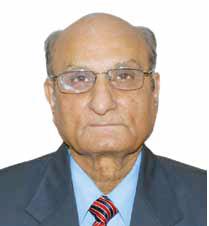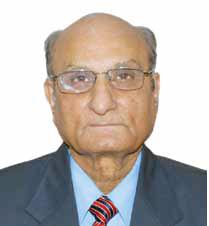
 Dr S K Parashar, President Elect and Chairman of the SC, Cardiology Society of India, shares his views on the developments that have taken place in Indian cardiology In conversation with Sharmila Das, ENN
Dr S K Parashar, President Elect and Chairman of the SC, Cardiology Society of India, shares his views on the developments that have taken place in Indian cardiology In conversation with Sharmila Das, ENN
Why there has been a rise of medical tourist in our country seeking for heart treatments?
The medical tourism is currently a booming multi million dollar industry. In any medical condition the patient desires (a) an excellent professional skill (b) minimum waiting period for surgery / intervention (c) comprehensive medical care under one roof (d) excellent post operative care (e) cost -effective treatment (f) state of the art medical institutes and hospitals of international standard. (g) availability of interpreters (h) highlighting the medical facilities available through their respective embassies and medical tourism operators (h) availability of air ambulances.

India is an important mainstream option providing solution to all the above needs. The professional skills of our cardiologists and surgeons can be matched with any Western counterpart. Our hospitals are extremely well equipped with all modern diagnostic and therapeutic facilities. Moreover our working system is such that any cross reference and investigations are completed within 24 “ 48 hours, so that the waiting period for treatment is significantly reduced. Highest level of post operative care service is provided which includes physical, mental and emotional well being. One of the biggest advantages in our country is significantly reduced cost of all cardiac procedures. Most of the patients come from Middle East countries, but now patients from Western countries are also coming. As there is no separate registry available of foreign patients, hence number cannot be judged.
So in brief some of the attractions to draw foreign patients are:
Availability of latest medical technologies
Adherence to international quality standards
Reduced costs
No language barrier. Availability of interpreters
Excellent hospitality right from day of admission to discharge
Surgical and intervention results comparable with Western counterparts.
In some hospitals separate wing is reserved for foreign patients and their special dietary needs are catered for
How would you measure the growth of cardiology in India?
There have been few important factors in the growth of cardiology. At first one of the main stimulating factors in the growth has been the rising cases of cardiovascular diseases. Moreover, possibly due to genetic factors, the onset is almost a decade earlier than the Western population. Double and triple vessel coronary disease is more common among Indians. As such there was an increased awareness of this disease. This led to more diagnostic and therapeutic options being explored. Secondly there was an increasing emphasis on training and education of young cardiologists. This was significantly enhanced by interactions with invited international experts who gave practical demonstrations in their field of research. Thirdly the increasing demand and advancements in medical devices and instrumentation played an important role in growth. There has been a massive growth of Echocardiographic industry hich greatly helped in earlier diagnosis, prognosis and management of cardiovascular disorders. Last, the mushrooming of high quality hospitals in private sector providing excellent healthcare cardiology services added to this growth.

According to you who are the forerunners of this growth story?
One of the earliest cardiologists to have contributed to this growth is Dr S Padmavati who established cardiac services in 1950s and early 1960. She had a lot of research work on rheumatic heart disease, coronary artery disease and hypertension. The credit of setting the first organised cardiac catheterisation laboratory in 1962 goes to Prof Sujoy B Roy of AIIMS which changed the face of cardiology in India and Delhi in particular. Prof Raj Tandon and Savitri Shrivastava of AIIMS immensely contributed to the growth of pediatric cardiology which, due to their efforts, is now a recognised major specialty in India. Before the growth of interventional cardiology in India, some surgeons played a stellar role in revolutionising cardiology. Dr Naresh Trehan gets the credit of changing the face of cardiology in Delhi by making an excellent corporate hospital namely Escorts Heart Institute. However he brought world class medical services in India through Medanta Medicity. Dr MR Girnath deserves a special mention by initiating first cardiac surgery centre at Apollo Hospital in Chennai.
Dr Ramakant Panda, Dr S Bhattacharya from Mumbai and many others were pioneers in cardiac surgery in India. A big breakthrough was initiation of interventional cardiology i.e. non surgical management of various cardiovascular disorders. Initial leaders in this field have been Dr Ashok Seth and Dr Purshottam Lal from New Delhi who have had maximum experience in this field. Now, of course, there are numerous experienced interventional cardiologists in the country.
What are new areas of development in Indian cardiology?
In every field of cardiology and cardiac surgery there has been notable progress in the last few years. In surgery, beating heart surgery, minimally invasive surgery, robotic and total endoscopic coronary bypass surgery, advances in valve repair, aortic surgeries, pediatric congenital cardiac corrective surgery, etc. are some of the advances. There has been significant progress in invasive and non invasive cardiology which has made tremendous impact. In invasive cardiology, advances in devices, stent technology, mechanical support devices for heart failure, pace maker technology, CRT, ICD, radio frequency ablation, coronary / peripheral angioplasties, valvular and congenital interventions have made a lasting impact. Cardiac MRI, CT and echocardiography have shown progressive innovations and have replaced cardiac catheterisations in large number of cardiac disorders. Hand held echocardiography equipment, almost the size of the palm, had a big diagnostic impact in emergency units.
There has been a progressive sophistication in cardiac catheterisation laboratory in the form of high resolution, low radiation, multiple view high frame rate systems, digital enhancing systems, 3-D imaging etc. We have a digital biplane cath lab system.
Be a part of Elets Collaborative Initiatives. Join Us for Upcoming Events and explore business opportunities. Like us on Facebook , connect with us on LinkedIn and follow us on Twitter , Instagram.












